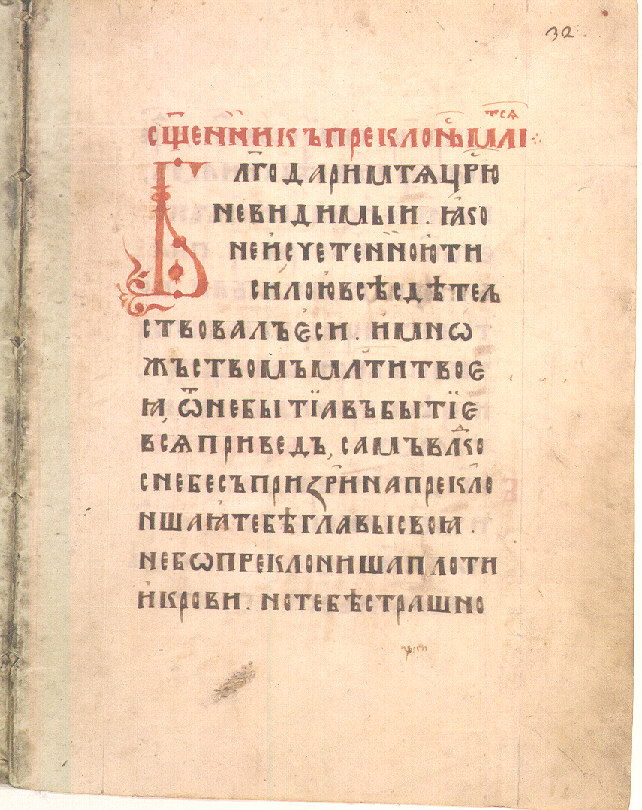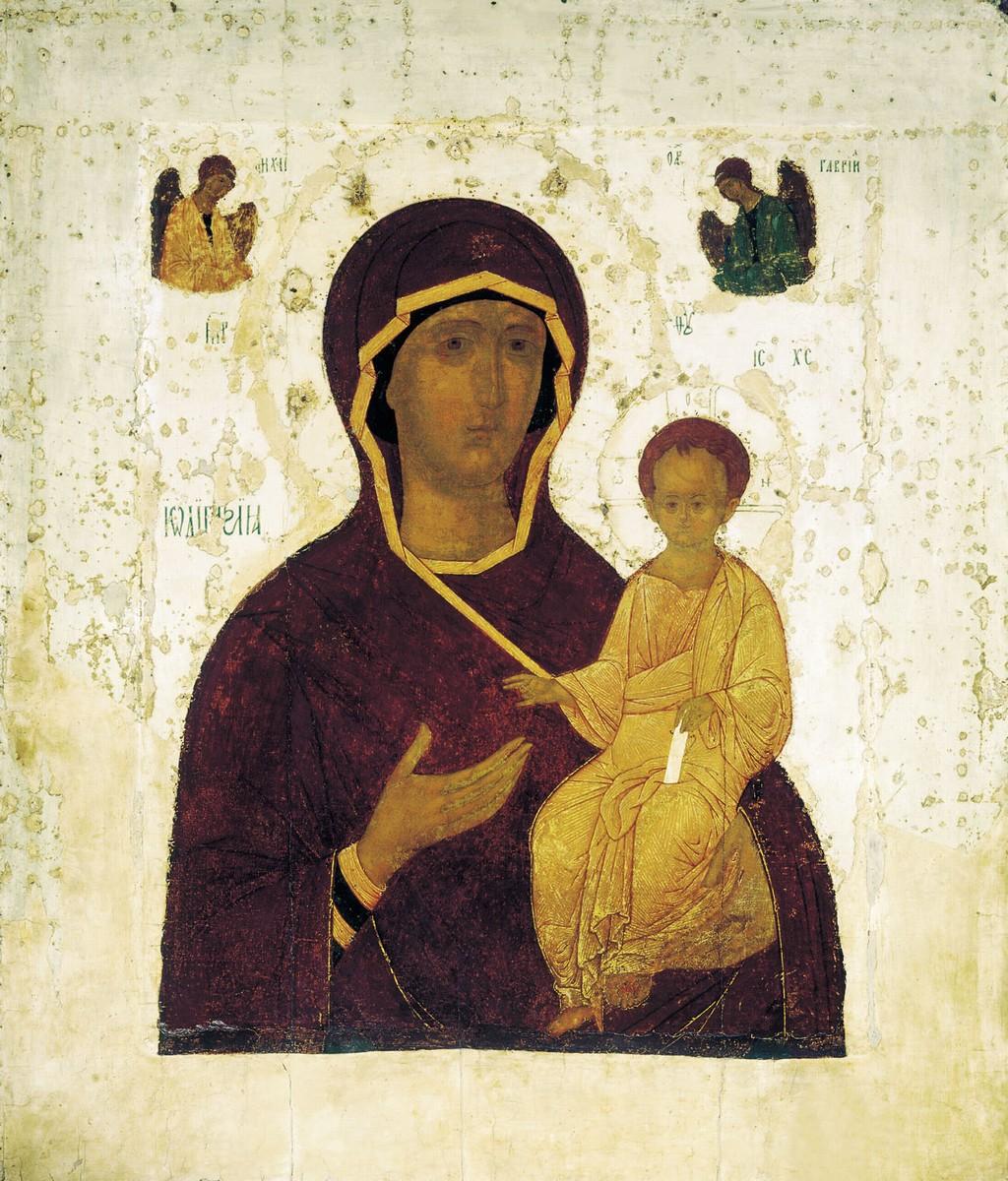|
Gregory II Bulgarian
Gregory the Bulgarian, or Gregory II ( 1458 – d. 1474) was the Metropolitan of Kiev, Galicia and all Rus'. His title to the metropolitan see was acknowledged both by the Holy See and by the Ecumenical Patriarchate of Constantinople due to their joint acceptance of the Council of Florence which united the Latin and the Eastern Orthodox Churches for a short period of time. He was consecrated by the Patriarch of Constantinople — Gregory III — in 1458. His canonical territory was the western part of the traditional Kievan Rus' lands — the states of the Grand Duchy of Lithuania and the Kingdom of Poland. The episcopal seat was in the city of Navahrudak which is today located in Belarus. Early life Gregory was born in Ottoman Bulgaria. He was a nephew of the Metropolitan of Kiev and All Rus' — Isidore of Kiev. He acted as Isidore's aide the Council of Florence in 1439. Career In 1448, Russian bishops in Moscow, who had rejected the Union with Rome, elected Jonah as Metrop ... [...More Info...] [...Related Items...] OR: [Wikipedia] [Google] [Baidu] |
Metropolis Of Kiev And All Rus'
The Metropolis of Kiev and all Rus' (russian: Митрополит Киевский и всея Руси, Mitropolit Kiyevskiy i vseya Rusi; ) was a metropolis of the Eastern Orthodox Church that was erected on the territory of Kievan Rus'. It existed between 988 AD and 1596 AD and later between 1620 AD and 1686 AD. Canonically, it was under the jurisdiction of the Ecumenical Patriarchate of Constantinople. The episcopal seat (''cathedra'') was located in the city of Kiev. History of Kievan Rus' to the Mongol invasions Christianization of Kievan Rus' The history of the Orthodox Church in the region of Kievan Rus' is usually traced to the Baptism of Rus' at Kiev. While the date of this event is commonly given as 988, the evidence is contested. In that year, Grand Prince of Kiev — Vladimir the Great — together his people, were baptised in the river Dniper by clergy of the Ecumenical Patriarch of Constantinople. There is a legendary account that the first bishop might have ... [...More Info...] [...Related Items...] OR: [Wikipedia] [Google] [Baidu] |
Isidore Of Kiev
Isidore of Kiev, also known as Isidore of Thessalonica or Isidore, the Apostate ( el, ; russian: Исидор; uk, Ісидор; 1385 – 27 April 1463), was a prelate of Byzantine Greek origin. From 1437 to 1441 he served as the Metropolitan of Kiev and all Rus' in the patriarchate of Constantinople of the Eastern Orthodox Church. He was a supporter of the Union of Florence which he proclaimed in Hagia Sophia on 12 December 1452.Isidore of Kiev , 2008, O.Ed. In the , Isidore was the |
Year Of Birth Unknown
A year or annus is the orbital period of a planetary body, for example, the Earth, moving in its orbit around the Sun. Due to the Earth's axial tilt, the course of a year sees the passing of the seasons, marked by change in weather, the hours of daylight, and, consequently, vegetation and soil fertility. In temperate and subpolar regions around the planet, four seasons are generally recognized: spring, summer, autumn and winter. In tropical and subtropical regions, several geographical sectors do not present defined seasons; but in the seasonal tropics, the annual wet and dry seasons are recognized and tracked. A calendar year is an approximation of the number of days of the Earth's orbital period, as counted in a given calendar. The Gregorian calendar, or modern calendar, presents its calendar year to be either a common year of 365 days or a leap year of 366 days, as do the Julian calendars. For the Gregorian calendar, the average length of the calendar year ( ... [...More Info...] [...Related Items...] OR: [Wikipedia] [Google] [Baidu] |
Bishops Of Kyiv
Bishop of Kyiv can refer to: *Metropolitan of Kiev and all Rus' (988-1685) * Bishop of Kyiv (Roman Catholic) {{Use dmy dates, date=April 2012 :''This is a list of Roman Catholic bishops of Kyiv. For Greek Catholic bishops of Kyiv, see List of Major Archbishops of Kyiv-Halych.'' Roman Catholic bishops of Kyiv diocese include: *1320–1334 Henryk, miss ... (since early 14th century) * The Greek Catholic Metropolitan of Kyiv (1596–1838) or Major Archbishop of Kyiv-Galicia (since 2000) * The Ukrainian Orthodox Church (Moscow Patriarchate) Metropolitan of Kyiv (since 1685) * The Orthodox Church of Ukraine Metropolitan of Kyiv (since 2018) ** The Ukrainian Autocephalous Orthodox Church Metropolitan of Kyiv (1921–1936, 1942–1953, 2000–2018) or Patriarch of Kyiv and All Rus-Ukraine (1990–2000) ** The Ukrainian Orthodox Church – Kyiv Patriarchate Patriarch of Kyiv and All Rus-Ukraine (1992–2018) {{DEFAULTSORT:Bishop Of Kiev Kiev ... [...More Info...] [...Related Items...] OR: [Wikipedia] [Google] [Baidu] |
Michael Rohoza
Michael Rohoza ( be, Міхал Рагоза, uk, Михайло Рогоза, pl, Michał Rahoza, russian: Михаил Рагоза) (died 1599) was the Metropolitan of Kiev, Galicia and all Rus' in the Patriarchate of Constantinople of the Eastern Orthodox Church from 1588 to 1596. In 1595, he signed the Union of Brest which moved the metropolis from the jurisdiction of the Patriarchate of Constantinople to the jurisdiction of the Holy See. By this act, the Ruthenian Uniate Church was formed in the territory of the Polish–Lithuanian Commonwealth. From 1596 until his death in 1599, he held the title of "Metropolitan of Kiev, Galicia and Ruthenia" in the Ruthenian Uniate Church. Early life Michael was born in Volhynia about 1540 from a noble Belarusians family in the region of Minsk county. He probably studied in a Jesuit college in Vilnius where he worked as clerk for the prince Bogush Koretsky, a voivode of Vilnius.Holovata, N. Mykhailo Rohoza'. Encyclopedia of History of ... [...More Info...] [...Related Items...] OR: [Wikipedia] [Google] [Baidu] |
Union Of Brest
The Union of Brest (; ; ; ) was the 1595–96 decision of the Ruthenian Orthodox Church eparchies (dioceses) in the Polish–Lithuanian Commonwealth to break relations with the Eastern Orthodox Church and to enter into communion with, and place itself under the authority of the Pope of Rome. The Eparchy of Mukachevo that was located in the Kingdom of Hungary was left out of the process. The union established the Ruthenian Uniate Church, which currently exists as the Ukrainian Greek Catholic Church, and the Belarusian Greek Catholic Church. The union Background Rome-oriented Christians and their Byzantium-oriented counterparts formally severed connections from 1054. Subsequent attempts to unify Eastern Orthodox believers and the Catholic Churches were made on several occasions, including an instance in 1452 in which the deposed Metropolitan of Kyiv Isidore (in office from 1437 to 1441) endorsed the 1439 Union of Florence and formally promised the unity of the Ruthenian ... [...More Info...] [...Related Items...] OR: [Wikipedia] [Google] [Baidu] |
Misail Pstruch
Misail Pstruch ( pl, Mizael Piestrucz; born undetermined date, died fall of 1480 or winter of 1480/81) was the Metropolitan of Kiev, Galicia and all Rus' in the Ecumenical Patriarchate of Constantinople of the Eastern Orthodox Church. Hrushevskyi M. Hierarchal relations (ЄРАРХІЧНІ ВІДНОСИНИ)'. History of Ukraine-Russia (at Izbornik). While he was recognised by King Casimir IV Jagiellon, he was not recognised by the Patriarch of Constantinople. Misail is better known for his letter to Pope Sixtus IV in connection to the Florentine Union. His real last name was Pestrutsky of Belarusian boyar family Drutsky-Sokolinsky-Babych. Misail established on his funds the Saint Trinity monastery in Czereja (today Chareja, Belarus) where he served as an archimandrite. In the beginning of 1450 he was appointed as the Archbishop of Smolensk. [...More Info...] [...Related Items...] OR: [Wikipedia] [Google] [Baidu] |
Kingdom Of Poland (1385–1569)
The Crown of the Kingdom of Poland ( pl, Korona Królestwa Polskiego; Latin: ''Corona Regni Poloniae''), known also as the Polish Crown, is the common name for the historic Late Middle Ages territorial possessions of the King of Poland, including the Kingdom of Poland proper. The Polish Crown was at the helm of the Polish–Lithuanian Commonwealth from 1569 to 1795. Major political events The Kingdom of Poland has been traditionally dated back to c. 966, when Mieszko I and his pagan Slavic realm joined Christian Europe (Baptism of Poland), establishing the state of Poland, a process started by his Polan Piast dynasty ancestors. His oldest son and successor, Prince Bolesław I Chrobry, Duke of Poland, became the first crowned King of Poland in 1025. Union of Krewo The Union of Krewo was a set of prenuptial agreements made in the Kreva Castle on August 13, 1385. Once Jogaila confirmed the prenuptial agreements on August 14, 1385, Poland and Lithuania formed a personal uni ... [...More Info...] [...Related Items...] OR: [Wikipedia] [Google] [Baidu] |
Dionysius I Of Constantinople
Dionysius I ( el, ), (? – 1492) was Ecumenical Patriarch of Constantinople two times, from 1466 to 1471 and from 1488 to 1490. He is honoured as a saint in the Eastern Orthodox Church and his feast day is November 23. Life Dionysius was born in Dimitsana, in the Peloponnese. He became a monk and entered in a monastery in Constantinople where he was a pupil of Mark, Archbishop of Ephesus, who ordained him as priest. During the Fall of Constantinople in 1453 he was enslaved by the Ottomans, but he was bought and freed some time later in Adrianople by an archon known as Kyritzes (probably Demetrios Apokaukos, one of the two Greek secretaries of Sultan Mehmed II). Following his release Dionysius became highly thought of by Mara Branković, daughter of the Serbian Despot Đurađ Branković and one of the wives of Sultan Murad II, the father of Mehmed II. Although Mara remained a lifelong Christian, she was quite influential with Mehmed. Supported by Mara, Dionysius was a ... [...More Info...] [...Related Items...] OR: [Wikipedia] [Google] [Baidu] |
Latin Patriarch Of Constantinople
The Latin Patriarchate of Constantinople was an office established as a result of the Fourth Crusade and its conquest of Constantinople in 1204. It was a Roman Catholic replacement for the Eastern Orthodox Ecumenical Patriarchate of Constantinople, and remained in the city until the reconquest of Constantinople by the Byzantines in 1261, whereupon it became a titular see. The office was abolished in 1964. History Before the East–West Schism in 1054, the Christian Church within the borders of the ancient Roman Empire was effectively ruled by five patriarchs (the "Pentarchy"): In descending order of precedence: Rome by the Bishop of Rome (who rarely used the title "Patriarch") and those of Constantinople, Alexandria, Antioch, and Jerusalem. In the West the Bishop of Rome was recognized as having superiority over the other Patriarchs, while in the East, the Patriarch of Constantinople gradually came to occupy a leading position. The sees of Rome and Constantinople were often at odd ... [...More Info...] [...Related Items...] OR: [Wikipedia] [Google] [Baidu] |
Pope Pius II
Pope Pius II ( la, Pius PP. II, it, Pio II), born Enea Silvio Bartolomeo Piccolomini ( la, Aeneas Silvius Bartholomeus, links=no; 18 October 1405 – 14 August 1464), was head of the Catholic Church and ruler of the Papal States from 19 August 1458 to his death in August 1464. He was born at Corsignano in the Sienese territory of a noble but impoverished family. He was a Renaissance humanist, famous as an author in Latin before he became pope. His longest and most enduring work is the story of his life, the ''Commentaries'', which is the only revealed autobiography ever to have been written by a reigning pope. This was only published in 1584. Early life Aeneas was born to Silvio, a soldier and member of the House of Piccolomini, and Vittoria Forteguerri, who had 18 children including several twins, though most died at a young age. He worked with his father in the fields for some years and at age 18 left to study at the universities of Siena and Florence. He settled in the f ... [...More Info...] [...Related Items...] OR: [Wikipedia] [Google] [Baidu] |





